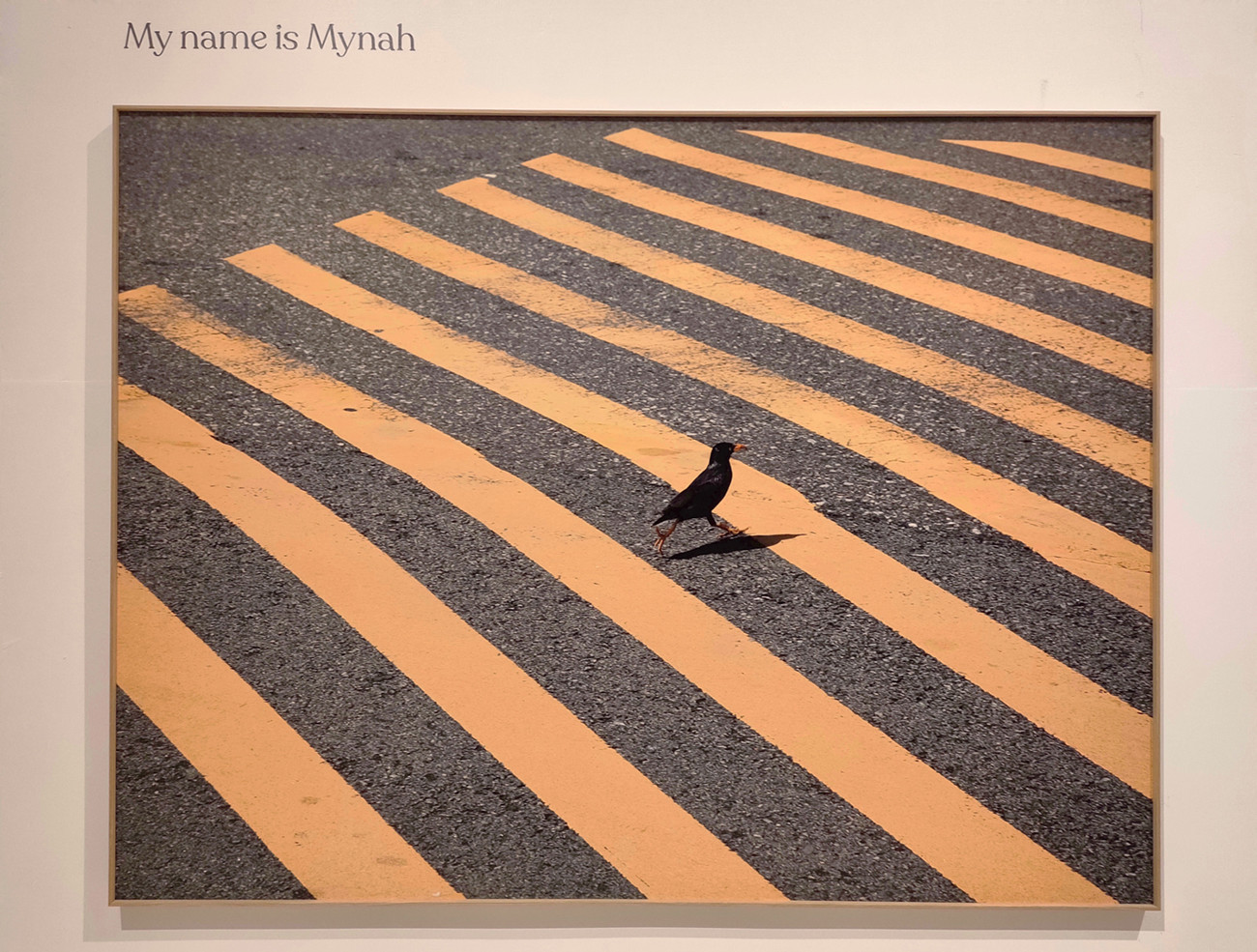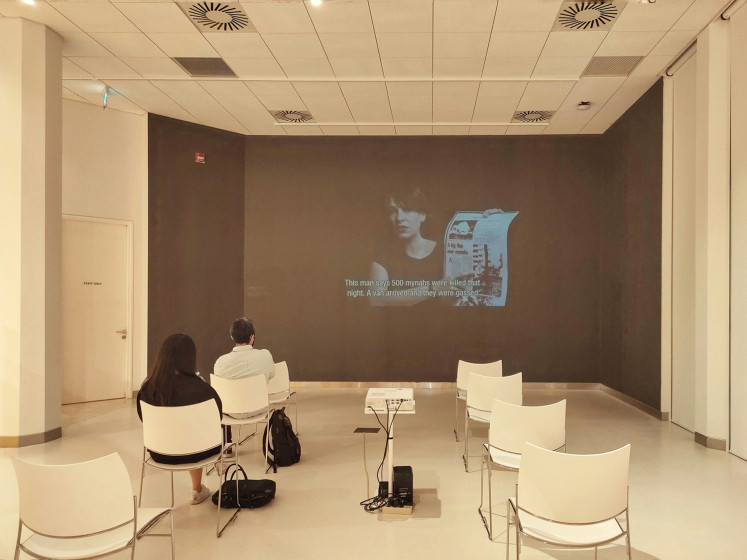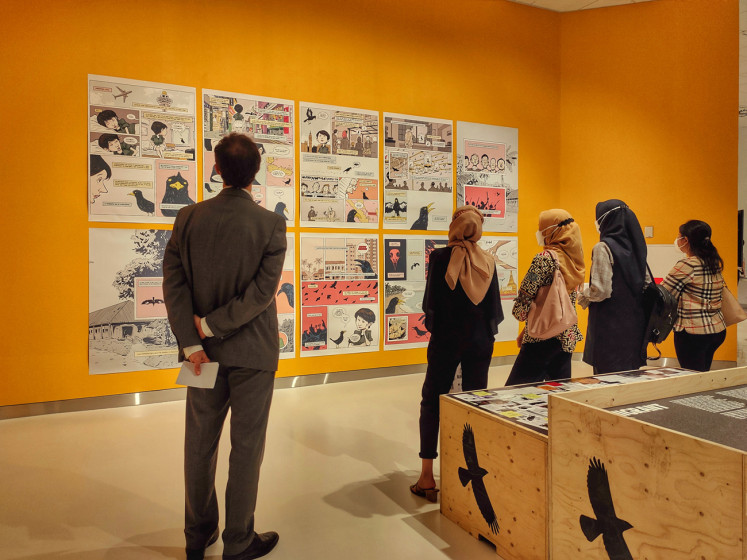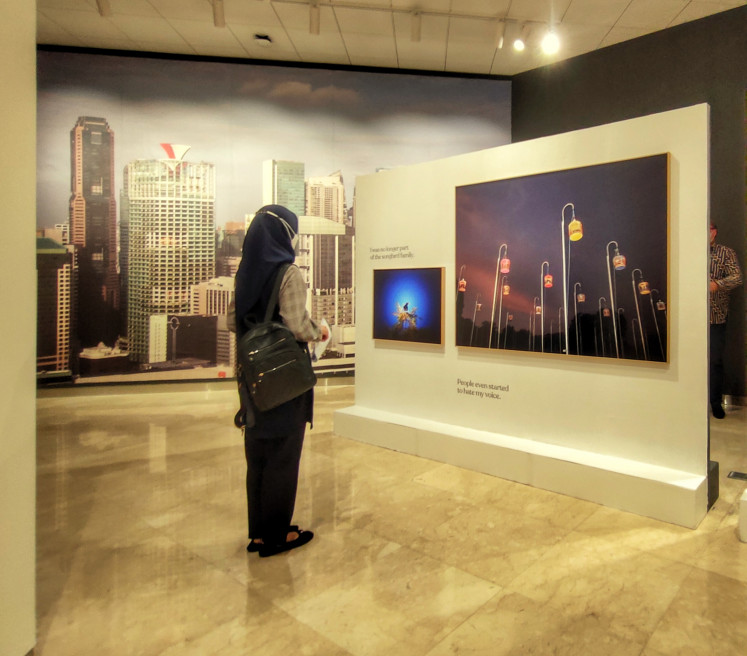Javan myna: A story of birds on the run
Change Size

Dutch-Spanish photographer Anaïs López celebrates an Indonesian bird in her latest work
What do the bird species known as the Javan myna and humans have in common? Just like us, they, too, can be taken from home, transported to a different land and labeled as “migrants” and “terrorists”. For the sake of controlling their population, these birds have been gassed, poisoned, shot at and had their wings clipped.
These disturbing facts are beautifully showcased by Dutch-Spanish photographer Anaïs López in The Migrant, an exhibition held at the Erasmus Huis Jakarta, from Jan. 20 to Mar. 6.
For The Migrant, the exhibition hall at Erasmus Huis Jakarta has been transformed to resemble Singapore, with floor-to-ceiling pictures of its glitzy skyscrapers towering over visitors walking through the exhibition. On the standing panels are displayed photos of Javan mynas in various settings; perched on a tree looking over tall buildings, flying in a flock across Singapore’s cloudy skies, jaywalking, caged and dead in a freezer.
“I use my camera to record the interaction between people and their urban surroundings, and ask the question: Do people make the city or the other way around?” López said in a Zoom interview with The Jakarta Post on Monday.
“In creating the ideal society, who do we exclude?” she asked.
Sounds of Javan mynas squawking and cars honking echo through the exhibition hall.

A chance encounter
López fell in love with Javan mynas in a chance encounter.
The photographer was invited to a project in Singapore in 2012. Arriving after a 12-hour flight from Amsterdam, she went straight to her hotel room in Little India and took a nap.
But a shrill noise woke her up.
Sitting at her window was a black bird, about the size of a sparrow, shrieking at the top of its lungs.
The photographer opened the window and tried to shoo it away.
“It looked at me and didn’t go away,” López said. “Considering the noise it was making, I was surprised at how small and elegant it was. It reminded me of a ballerina.”
The Javan myna, a member of the starling family, is mainly black with specks of white on its undertail. Its beak, legs and feet are yellow.
López had just completed another project, titled "In the Beginning No Bird Sang", at that time. For the project, the photographer had followed Jean Poppers, a blind man that recognizes almost every bird in Ijburg by their voices, for 18 months.
“One thing I learned from Jean is that birds never scream without reason,” the photographer said. “[Birds] are like people. When they scream, they need to say something.”
As the Javan myna in the hotel window would not stop screaming, López decided to go downstairs to take a look at it more clearly.
“And it was waiting for me on the street,” she said. “It walked really proud. And it could also imitate my speech. I was fascinated.”
Another day when López was sipping coffee in a shop in Singapore, she came across an article in The Straits Times that labeled the bird as “the new terrorist” for its unbearably loud voice.
She became intrigued.
“I wanted to know everything about the bird,” she said.

The birds on the run
There are two main types of mynas living in Singapore: the Indian myna and the Javan myna.
Originally from Java and Bali, the Javan myna was first introduced to Singapore in the 1920s through caged bird trade. Carl Alexander Gibson-Hill, a British ornithologist and curator of Singapore’s Raffles Museum, categorized Javan mynas as “migrants” in 1949. And the bird’s standing in society slumped even further when their beautiful voice evolved to a shrill screech to compete with the growing urban noise in the city-state.
There are now more than 100,000 Javan mynas living in Singapore. They usually roost in trees near residential areas, driving their inhabitants crazy with deafening squeals.
López’ further research in Singapore’s National Library revealed horrific ways in which local inhabitants have been trying to control the bird’s population and sterilize their neighborhoods of its noise.
Since 1981, members of the Singapore Gun Club have been authorized to shoot at these birds.
In 1988, a mysterious van parked on Ang Mo Kio Street sprayed chemicals on the trees where these birds sleep and caused hundreds of them to drop dead in a single night.
A more recent incident, in 2019, saw 2,800 of these birds in Potong Pasir “humanely euthanized with carbon dioxide”.
And there are many more similarly heart-wrenching reports in the library.
“And I thought, ‘Poor bird,’” López said. “You truly have a terrible life. We’re horrible.”
The photographer then decided to do a story on Javan mynas and tell it to the world.
“I followed them for five years and tried to find out everything about them,” she said.
The photographer also joined a hunting trip by the Singapore Gun Club that went to the Malaysia-Singapore border to shoot at any Javan mynah crossing over.
“[Members of the Singapore Gun Club] are really, really nice people,” she said. “But they believe in their values as a clean city [with] well-behaved [citizens]. And these birds are not well behaved. They believe [the birds] don’t belong in Singapore. They’re treated as migrants.”

A story of migrants
As López was flying back and forth between Singapore and Amsterdam to do the story, she told her visiting mother-in-law about these birds.
“[My mother-in-law] started to cry,” the photographer said. “And she’s a tough cookie. She’s a hard-working woman that doesn’t break easily. But when I told her the story, she said, ‘Well, that’s my life. That’s how people treated me here.’”
Between the 1960s and 1970s, many young people in Spain, including López’ mother-in-law, were recruited to work in the Netherlands.
“She said, ‘we were received with open arms to build the society here’,” the photographer said. “And once it was built, they were asked kindly to leave. And if they wouldn’t, people would complain about them. They would call the police about them. They would say, ‘You’re the migrant. We don’t know you. So, we don’t want you here.’”
A documentary film, looping at the exhibition hall of Erasmus Huis Jakarta, features members of the Singapore Gun Club posing for pictures with the birds they killed. A man even boasted that he had killed 129 of these birds in a single outing.
“It’s scary,” Sandra von Hellemond, a consumer research specialist and visitor to the exhibition, said when interviewed during the opening night. “[Members of Singapore Gun Club] feel like they’re doing justice by killing the birds.”
“And then on a deeper meaning, it’s what’s happening in the world,” Von Hellemond continued. “In the documentary, you could see that the bird changed its voice as it didn’t feel at home. It’s what happens to people, if they move to another country, maybe not out of free will, they suffer.”
Seeing (and feeling) through the bird’s eyes
Gideon Guruh Satrio, a private sector employee and bird enthusiast, came especially from Semarang to see the exhibition at the Erasmus Huis Jakarta.
“It’s an eye-opening exhibition,” he said. “When I was a kid, I used to see these birds in the fields. I rarely spot them anywhere now. But now I know that they thrive in another country, albeit hated and hunted.”
The population of the Javan myna, known as jalak kebo, has declined sharply in Indonesia. It is estimated that there are currently less than 2,000 of them in the country.
“I also love how they arrange the photos in the exhibition,” Gideon said. “As we go through them, we can feel and imagine what it’s like to be these birds living in the metropolis.”
The exhibition, held until March 6, is open from Tuesday to Saturday from 10 a.m. to 4 p.m. Visitors must be fully vaccinated or show a negative antigen test. Unvaccinated children may also come, only if accompanied by adults that are fully vaccinated.
“The Erasmus Huis is very pleased to open this year with the fascinating exhibition around the Javan myna,” Yolande Melsert, director of the Erasmus Huis Jakarta, said. “Since borders are closed and traveling is still not possible, this exhibition gives you the opportunity to travel via the eyes of the Javan bird.”
Those who haven’t had a chance to see the exhibition, can also visit migrant.nu/en, a website dedicated to the project, and discover the story of the birds on the run.









